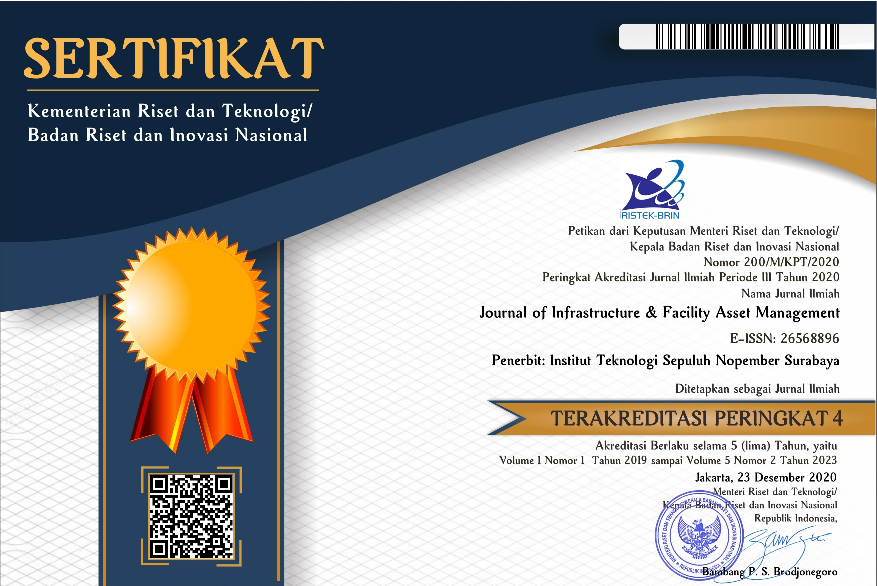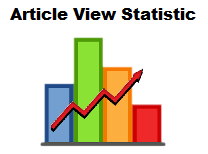Behaviour Study of Abutment Foundation Pile on Lightweight Embankment Oprit (Case Study: Kali Otek Bridge – Lamongan North Ring Road Construction Package Section 2)
Nila Wahyu Pertiwi, Ria Asih Aryani Soemitro, Trihanyndio Rendy Satrya, Sifa’ Udukha
Abstract
The Kali Otek Bridge is in the Lamongan North Ring Road Development Package Section 2 with a bridge span length of 40.8m. The boring test results show that the subgrade is included in the very soft soil classification to a depth of >15 meters. The existing condition is a pond area that can be inundated with water reaching a height of 1 meter, thus affecting the occurrence of land subsidence and stability of the bridge abutment foundation pillars. The existence of embankment construction can also cause subsidence on the subgrade.
In this research, soil settlement and stability analysis of lightweight foam mortar embankment has been carried out by varying the percentage of the height of the existing embankment and the foam mortar. In addition, it also analyzes the effect of using lightweight embankment, both as a whole and its variations on the stability of bridge abutment foundation piles, both with and without Prefabricated Vertical Drain (PVD).
The analysis showed that the use of foam mortar reduced the subgrade settlement by 61.2% with a longer time of 18.5%. The smallest settlement and lateral deflection was at 100% foam mortar backfill variation with consolidation time of 190 days. The greater the percentage of foam mortar height, the smaller the settlement as the factor of safety increases. Thus, the use of foam mortar can be an alternative embankment for bridge oprites on soft soil.
References
ACI Committe 523. (2014). Guide for Cellular Concrete Above 50 lb/ft3 (800kg/m3), ACI 523.3R-14.
Das, Braja M. 1988. Mekanika Tanah (Prinsip-Prinsip Rekayasa Geoteknik) Jilid 1. Alih Bahasa oleh Ir. Noor Endah dan Ir. Indrasurya. Erlangga. Jakarta.
Das, Braja M. 1988. Mekanika Tanah (Prinsip-Prinsip Rekayasa Geoteknik) Jilid 2. Alih Bahasa oleh Ir. Noor Endah dan Ir. Indrasurya. Erlangga. Jakarta.
Direktorat Jenderal Bina Marga. (2024). Spesifikasi Khusus Interim Material Ringan-Mortar Busa SKh.2.7.21. Direktorat Jenderal Bina Marga Kementerian PUPR. Jakarta.
Gunawan, Anthony. (2020). Geofoam: A Potential for Indonesia’s Soil Problem. IOP Conf. Series: Earth and Environment Science 426 (2020) 012004.
Gusnadi, Z., Rahardjo, P. & Lim, A. (2021). Analisis Efek Vakum Konsolidasi terhadap Fondasi Tiang Pancang Terpasang. Simposium Nasional Teknologi Infrastruktur Abad ke-21 (pp. 670-675). Universitas Gadjah Mada. Yogyakarta.
Hidayat, D., Muslih Purwana, Y., dan Pramesti, F.P. (2016). Analisis Material Ringan Dengan Mortar Busa Pada Konstruksi Timbunan Jalan. Fakultas Teknik Universitas Muhammadiyah Jakarta, 8 November 2016.
Lastiasih, Y. dan Mochtar, I.B. (2022). “Comparison Study of Embankment Filledwith Selected Material and Foamed Mortar on Toll Road”. Indonesian Geotechnical Journal, Ahli Teknik Tanah Indonesia. Vol. 1 No. 2, pp.12-26.
Numan, A., Taufik, R., Iqbal, M. (2012). Evaluasi Kinerja Jangka Panjang Timbunan Oprit Jembatan dengan Material Beton Ringan. Kolokium Jalan dan Jembatan.
Rahardjo, P. P. (2013). Buku Manual Pondasi Tiang. Universitas Katolik Parahyangan. Bandung.
Wahyudi, H. (1999). Daya Dukung Pondasi Dalam. Jurusan Teknik Sipil, Fakultas Teknik Sipil dan Perencanaan, Institut Teknologi Sepuluh Nopember. Surabaya.
DOI:
http://dx.doi.org/10.12962%2Fjifam.v7i0.22475
Refbacks
There are currently no refbacks.
Visitor :
<div class="statcounter"><a title="Web Analytics" href="https://statcounter.com/" target="_blank"><img class="statcounter" src="https://c.statcounter.com/12008982/0/d95abe05/0/" alt="Web Analytics"></a></div>
Author Affiliate Statistics
View My Stats
Flag Counter
Journal Of Infrastructure & Facility Asset Management by Institut Teknologi Sepuluh Nopember is licensed under a Creative Commons Attribution-ShareAlike 4.0 International License .
Cendanatoto
Situs Toto
http://earthlearning.unimol.it/
https://flz.sabu.edu.ly/
Cendanatoto
Cendanatoto
Slot Thailand
Cendanatoto
Slot Gacor
Slot Gacor
Toto Slot
Toto Slot
Cendanatoto
Slot Gacor
Slot Dana
Cendanatoto
Cendanatoto
Kementerian Pemberdayaan Perempuan dan Perlindungan Anak Indonesia
BRIN - Badan Riset dan Inovasi Nasional
Cendanatoto
Toto Togel
https://wapresi.id
https://liputannewstoday.id/
pedia288
pedia288
Cendanatoto
Cendanatoto
Cendanatoto
Cendanatoto
https://kemkessumut.id/
https://maritimeacademy.id/
https://kadinlanggur.id/
Okejitu
Kapital4D
Kapital4D
Kapital4D
Kapital4D
Kapital4D
Kapital4D
Kapital4D
Kapital4D
Kapital4D
Kapital4D
Kapital4D
CendanaToto
KapitalSlot
Kapital4D
KapitalSlot
Kapital4D
Kapital4D
Kapital4D
Cendanatoto
Situs Slot Gacor Maxwin
Pedia288
CendanaToto
Pedia288
CendanaToto
Pedia288
CendanaToto
Pedia288
Kapital4D
Kapital4D
Pedia288
Kapital4D
Pedia288
KapitalSlot
Pedia288
Kapital4D
KapitalSlot
KapitalSlot
KapitalSlot
KapitalSlot
KapitalSlot
Kapital4D
Kapital4D
Rejekibet
KapitalSlot
Kapital4D
Kapital4D
KapitalSlot
CendanaToto
KapitalSlot
Kapital4D
CendanaToto
Kapital4D
Okejitu
CendanaToto
CendanaToto
Slot777
Slot Gacor
Kapital4D
KapitalSlot
CendanaToto
CendanaToto
Kapital4D
CendanaToto
CendanaToto
Kapital4D
Slot Gacor 4D
Kapital4D
Pedia288
Slot 4D
CendanaToto
Pedia288
KapitalSlot
Kapital4D
Slot Online
Slot Gacor 4D
CendanaToto
Toto Slot
CendanaToto
Slot Gacor Maxwin
Kapital4D
Slot Gacor 777
Kapitalslot
Slot Gacor 4D
Toto Togel
Slot Gacor
Situs Toto
CendanaToto
Kapital4D
Pedia288
CendanaToto
KapitalSlot
Pedia288
Okejitu
Kapital4D
KapitalSlot
Pedia288
Kapital4D
Okejitu
CendanaToto
KapitalSlot
Okejitu
Kapital4D
CendanaToto
Pedia288
Okejitu
Kapital4D
PEDIA288
TOTO SLOT
TOTO TOGEL
CENDANATOTO
Scatter Hitam
Cendanatoto
Cendanatoto
Cendanatoto
https://www.cityofnorthfield.org/
Kapital4D
Cendanatoto
Cendanatoto
cendanatoto
cendanatoto
cendanatoto
cendanatoto
cendanatoto
cendanatoto
cendanatoto
Slot Thailand
Cendanatoto
Cendanatoto
Slot777
Cendanatoto
Cendanatoto
Cendanatoto
Slot777
toto slot
Okejitu
CendanaToto
Pedia288
CendanaToto
KapitalSlot
Cendanatoto
Okejitu
CendanaToto
KapitalSlot
Pedia288
KapitalSlot
CendanaToto
Kapital4D
rumahpusbin.org
jurnal-desa.id
RSUD Madiun
simakuniga-desa.id
RSUDBM
RSUD Ulin Banjarmasin
Tabalongkub
Website Resmi Bogor Timur Indonesia
Madiun
Tabolakkab Resmi Kabupaten Konawe Selatan
Rumah Pangan Kita Distribusi Pangan Resmi Peluang Usaha Modal Terjangkau
Direktorat Jenderal Pajak Terkini Dan Terpercaya
Rita Hazan
Potretterkini
Kabupaten Madiun Indonesia
al-ainrestaurants.com
Rumah Sakit Umum Kabupaten Kendal Masyarakat Selalu Hidup Sehat Dan Bahagia
Toko-Pedia
Kadin Sumatera Sistem Informasi Kamar Dagang Industri Indonesia
Caplang
Buka Lapak
Toko Sepatuh
Kadin Sumatera Selatan Sistem Informasi Kamar Dagang Industri Indonesia
Kadin Sumatra Utara
k
Kota Demak Terkini Dan Terbaru Hari Ini
Berita Kota Madiun Terkini dan Terbaru Hari ini
RS UI Universitas Indonesia
BUDHI DARMA INDRAPURA
Rumah Sakit Umum RSUD Cicalengka Provinsi Jawa Barat
Kabupaten Tasikmalaya
Badan Amil Zakat Nasional
KABUPATEN KAPUAS
Sidbankumda
DisnakerTrans
Berita Madiun
KatinganKab
Children's National Hospital - Ranked Top 10 in the Nation
Murni Teguh Memorial Hospital Kota Jakarta
Mayo Clinic Rochester,Minnesota
RS Persahabatan Kota Jakarta Timur
RS Adam Malik Medan Terjangkau, Efisien, Nyaman
(RSUD) Dr. Dradjat Prawiranegara Kabupaten Serang
pafiipalembang.org
hipmijatengprov.org
hipmidemakk.org
pafiibandung.org
pafitebingtinggii.org
parikotajakarta.org
parikotalubuklinggau.org
hipmikotamedan.org
parikotalhokseumawe.org
hipmisiantar.org
hipmikisarankota.org
parikotalangsa.org
hipmikalimantan.org
parikotamakassar.org
pafiipalembang.org
hipmikotakediri.org
Okejitu
parikotabatam.org
Pedia288
hipmisubangkota.org
hipmisumatra.org
hipmisumatra.org
parikabpapuabarat.org
Pedia288
hipmisulawesi.org
hipmitenggara.org
hipmisumatraselatan.org
hipmisumatrabarat.org
paficabangmedankota.org
pafisiabu.org
pafisingkuang.org
pafiparit.org
paritegall.org
parijawa.org
paribandahaceh.org
parikabpapuabarat.org
parikotamedan.org
pariprovmedan.org
parikotajogja.org
parikotasiantar.org
parikotapapua.org
paripapuautara.org
Toto Slot
Cendanatoto
Slot Thailand
Pedia288
https://kemkespapuaselatan.id/
https://kemkespapuapegunungan.id/
https://kemkespapuatengah.id/
https://kemkespabarprov.id//
https://kemkesmalukuprov.id/
https://kemkessultengprov.id/
https://kemkeskalselprov.id/
https://kemkeskaltengprov.id/
https://kemkesbengkuluprov.id/
https://kemkesjambiprov.id/
https://kemkeskepriprov.id/
https://kemkesriau.id/
https://kemkesumbarprov.id/
https://kemkesacehprov.id/
https://simonakemkes.id/
https://jatengprov.org/
https://kotajatengprov.org/
https://jdih-kemkes.id/
BMKG - Badan Meteorologi, Klimatologi, dan Geofisika Indonesia
pedia288
pedia288
Cendanatoto
Toto Slot
Slot Gacor
Toto Slot Gacor
Slot Gacor 777
Slot Gacor Resmi
Situs Slot88 Gacor
Slot Bet 200 Perak
Slot Online Resmi
Slot Online Gacor
Slot Bet 200 Resmi
Slot Gacor 777
Slot Thailand Resmi
Slot Gacor 4D
Slot Online Gacor
Slot Online Terbaru
Slot Modal Receh
Slot Banjir Maxwin
Slot Online
Slot Online Gacor
Slot Gacor 777
Slot Thailand
Slot Pulsa
Slot Scatter Hitam
Slot Gacor 4D
Slot Super Gacor
Slot Thailand
Slot Online
Cendanatoto
batiktoto
Kapitalslot
Cendanatoto
Okejitu
Slot Gacor 2025
Bandar Toto Resmi
Slot Gacor
Slot Online
Slot88
Situs Slot Gacor
Slot88
Slot Bet 200
Slot Bet Kecil
Slot Gacor 2025
Slot Gacor Hari Ini
Slot Online
Slot Scatter Hitam
Slot777
Slot Gacor 2025
Slot Gacor
Slot Dana
Okejitu
Kapital4D
CendanaToto
Kapital4D
CendanaToto
Kapital4D
CendanaToto
Kapital4D
CendanaToto
Kapital4D
CendanaToto
Kapital4D
CendanaToto
Kapital4D
CendanaToto
Kapital4D
CendanaToto
Kapital4D
CendanaToto
Kapital4D
Cendanatoto
Cendanatoto
Bandar Togel Terpercaya
Slot Gacor
CENDANATOTO
SLOT777
SLOT MAXWIN
Cendanatoto
Cendanatoto
Slot Gacor
CENDANATOTO
CENDANATOTO
CENDANATOTO
CENDANATOTO
fixtoto
Cendanatoto
Prediksi Hk
RUPIAHSLOT
CENDANATOTO
CENDANATOTO
TOTO SLOT
Lohanslot
Lohanslot
Cendanatoto
Kapital4D
Kapital4D
CendanaToto
CendanaToto
KapitalSlot
Kapital4d
Slot Gacor
Cendanatoto
Cendanatoto
Cendanatoto
Cendanatoto
Cendanatoto
Cendanatoto
Cendanatoto
Cendanatoto
Cendanatoto
Cendanatoto
CENDANATOTO
Cendanatoto
Kapital4d
https://quotespics.com/category/humor/
Kapital4d
Bolahoki
BolaHoki
Cendanatoto
Toto Slot
Bandar Togel
CENDANATOTO
CENDANATOTO
CENDANATOTO
Cendanatoto
Slot777
Cendanatoto
Cendanatoto
Toto Slot
Cendanatoto
Cendanatoto
Cendanatoto
slot toto
situs toto
cendanatoto






